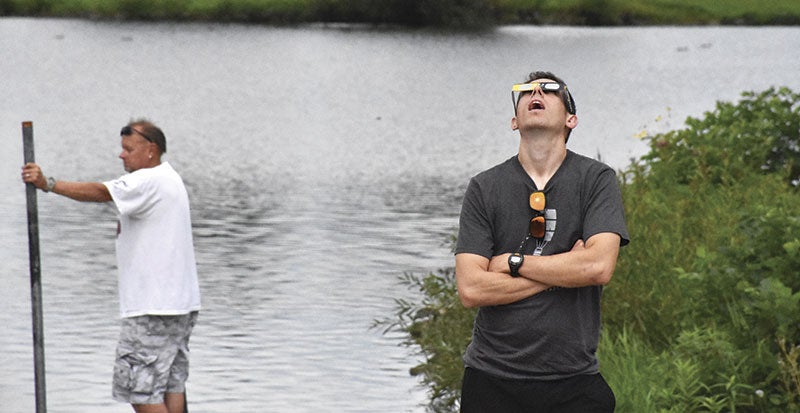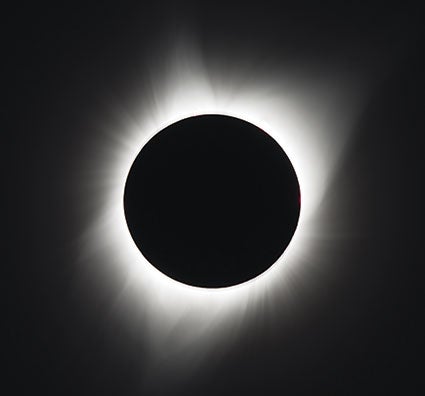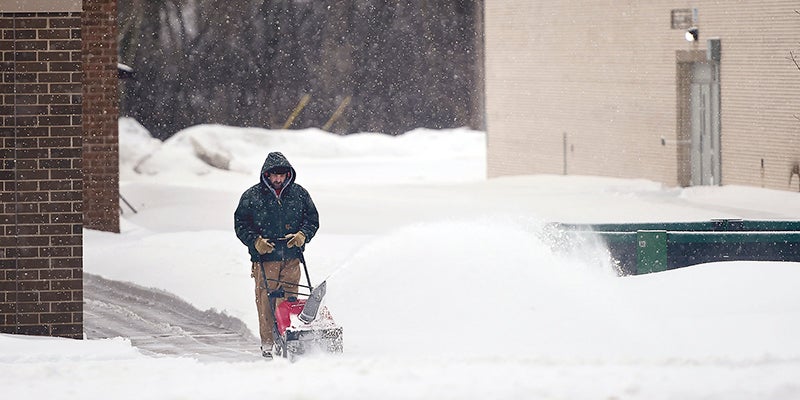Americans dazzled as eclipse turns day into night; Shadow came ashore in Oregon, traveled to S.C.
Published 8:06 am Tuesday, August 22, 2017

- Mariano Garcia of Minneapolis watched a partial solar eclipse Monday along the shoreline of East Lake in Austin. He headed south for a better view of the eclipse, stopping in Austin because it was the clearest spot at the time. Chris Baldus/chris.baldus@austindailyherald.com
By Marcia Dunn
Associated Press
Millions of Americans gazed in wonder through telescopes, cameras and disposable protective glasses Monday as the moon blotted out the sun in the first full-blown solar eclipse to sweep the U.S. from coast to coast in nearly a century.
“It was a very primal experience, it really was,” Julie Vigeland, of Portland, Oregon, said after she was moved to tears by the sight of the sun reduced to a silvery ring of light in Salem. “I’ve seen other really magnificent things, but there is nothing, nothing like this. Absolutely nothing.”
The temperature drop-ped, birds quieted down, crickets chirped and the stars came out in the middle of the day as the line of darkness raced 2,600 miles across the continent in about 90 minutes, bringing forth oohs, aahs and shouts.
In Boise, Idaho, where the sun was more than 99 percent blocked, people clapped and whooped, and the street lights came on briefly, while in Nashville, Tennessee, people craned their necks at the sky and knocked back beers at Nudie’s Honky Tonk bar.
At the Nashville Zoo, the giraffes started running around crazily in circles when darkness fell, and the flamingos huddled together, though zookeepers aid it wasn’t clear whether it was the eclipse or the noisy, cheering crowd that spooked them.
Several minor-league baseball teams — one of them, South Carolina’s Columbia Fireflies, outfitted for the day in glow-in-the-dark jerseys — briefly suspended play.
At the White House, despite all the warnings from experts about the risk of eye damage, President Donald Trump took off his eclipse glasses and looked directly at the sun.
It was the most-observed and most-photographed eclipse in history, with many Americans staking out prime viewing spots and settling onto blankets and lawn chairs to watch, especially along the path of totality — the line of deep shadow created when the sun is completely obscured except for the ring of light known as the corona.
The shadow — a corridor just 60 to 70 miles wide — came ashore in Oregon and then traveled diagonally across the Midwest to South Carolina, with darkness from the totality lasting only about two to three wondrous minutes in any one spot.
The rest of North America was treated to a partial eclipse, as were Central America and the top of South America.
With 200 million people within a day’s drive from the path of totality, towns and parks saw big crowds. Skies were clear along most of the route, to the relief of those who feared cloud cover would spoil this once-in-a-lifetime moment.
NASA reported 4.4 million people were watching its TV coverage midway through the eclipse, the biggest livestream event in the space agency’s history.
“It can be religious. It makes you feel insignificant, like you’re just a speck in the whole scheme of things,” said veteran eclipse-watcher Mike O’Leary of San Diego, who set up his camera along with among hundreds of other amateur astronomers gathered in Casper, Wyoming.
A solar eclipse is considered one of the grandest of cosmic spectacles.
NASA solar physicist Alex Young said the last time earthlings had a connection like this to the heavens was during man’s first flight to the moon, on Apollo 8 in 1968. The first, famous Earthrise photo came from that mission and, like this eclipse, showed us “we are part of something bigger.”

A total solar eclipse is seen on Monday above Madras, Oregon. A total solar eclipse swept across a narrow portion of the contiguous United States from Oregon to South Carolina. Courtesy of NASA/Aubrey Gemignani
Hoping to learn more about the sun’s composition and activity, NASA and other scientists watched and analyzed from telescopes on the ground and in orbit, the International Space Station, airplanes and high-altitude balloons beaming back live video.
Citizen scientists monitored animal and plant behavior as day turned into twilight. About 7,000 people streamed into the Nashville Zoo just to watch the animals’ reaction and noticed how they got noisier as it got darker.
The Earth, moon and sun line up perfectly every one to three years, briefly turning day into night for a sliver of the planet. But these sights normally are in no man’s land, like the vast Pacific or Earth’s poles.
The moon hasn’t thrown this much shade at the U.S. since 1918, during the nation’s last coast-to-coast total eclipse. The last total solar eclipse on the U.S. was in 1979, but only five states in the Northwest experienced total darkness.





